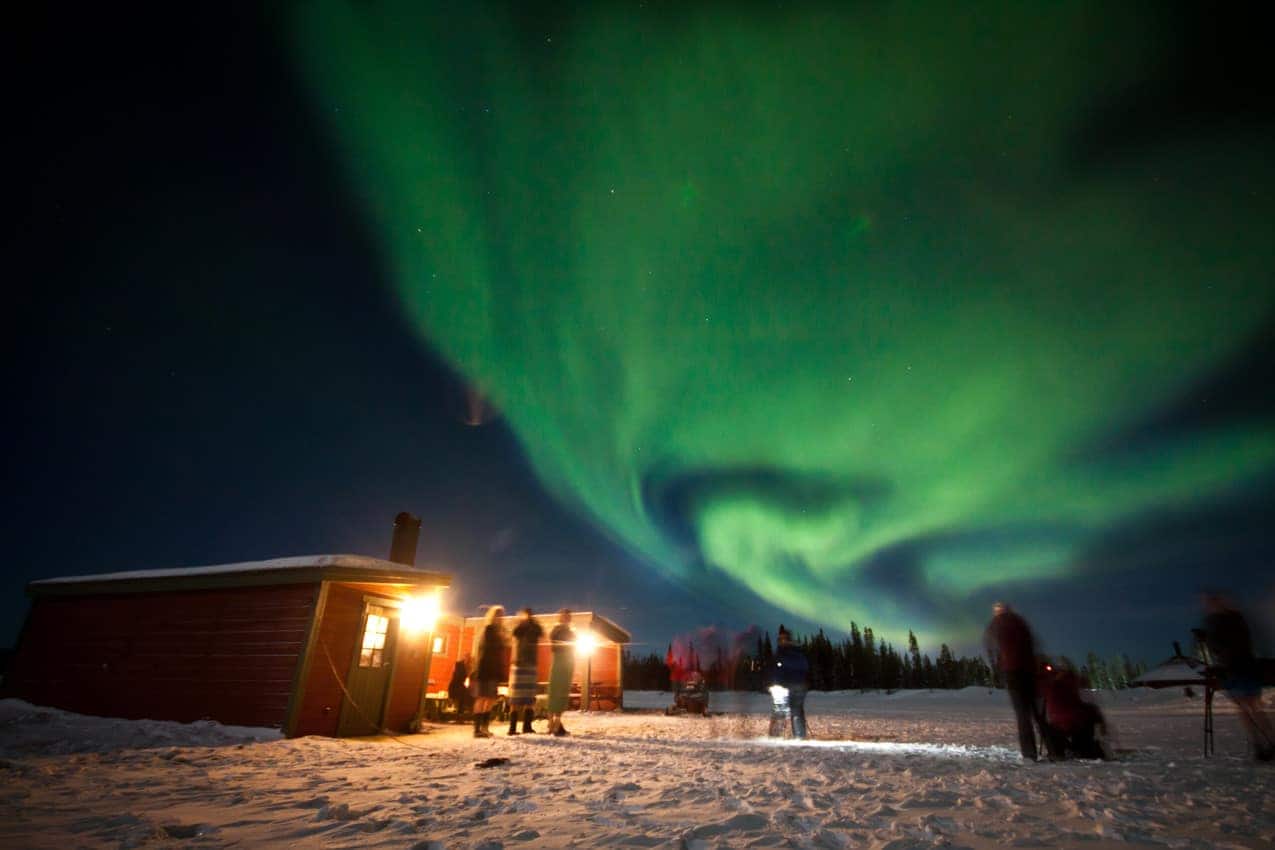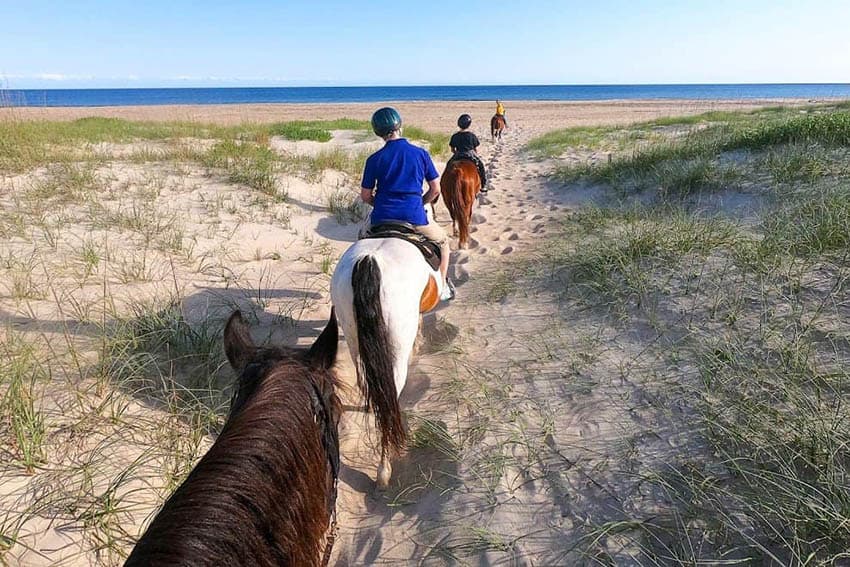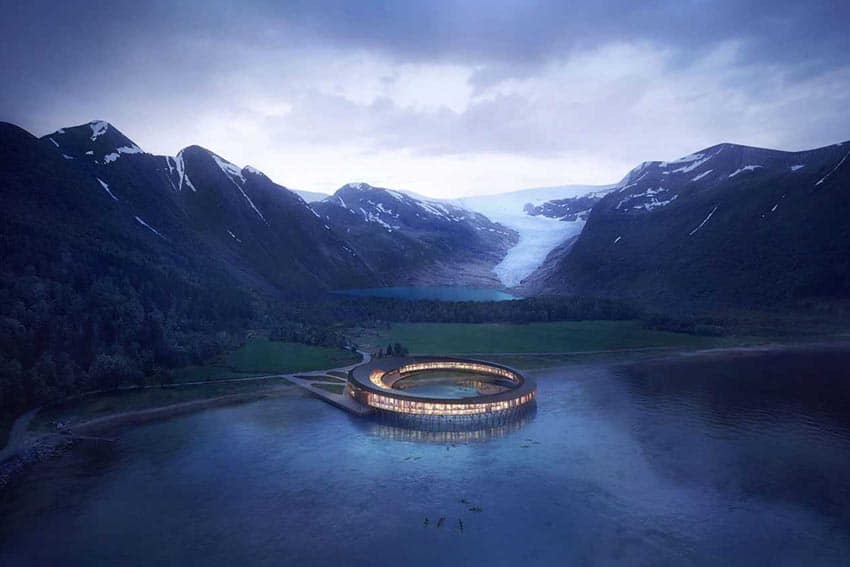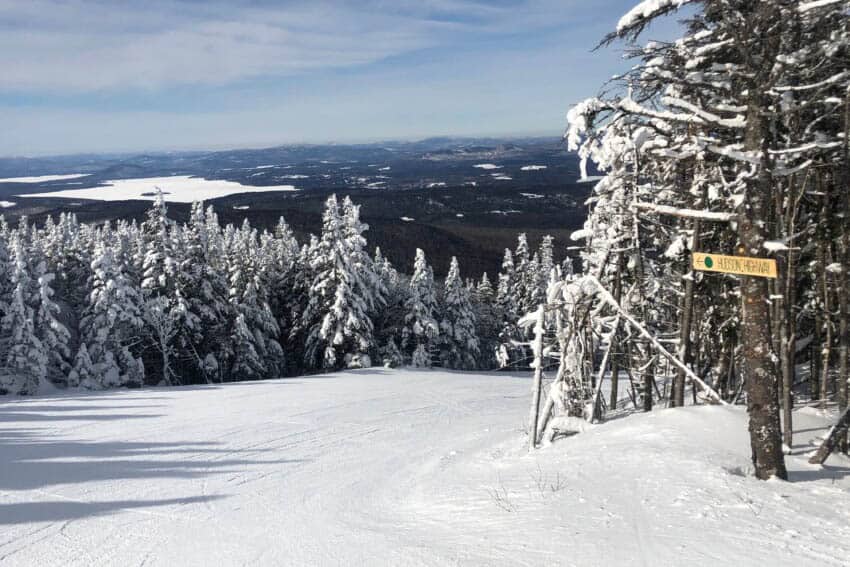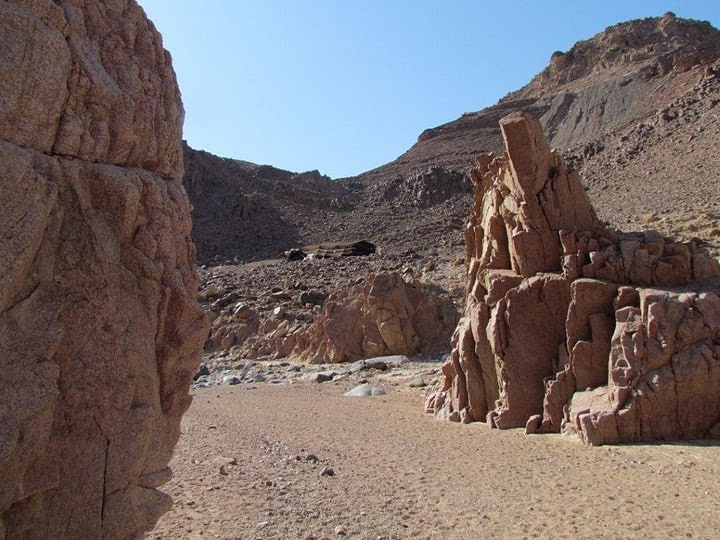
Jordan: An Adventurer’s Paradise
By Robert Painter

If you know anything at all about the Hashemite Kingdom of Jordan you’re probably aware of the Rose Red City of Petra, one of the modern Seven Wonders of the World.
And, surely you’ve heard of the Dead Sea even if you don’t know of the beautiful resorts along the waterfront, like the Moevenpick and the Marriott where you can cake yourself in black mud from the pots along the beach and then lie on top of the salty sea water.
That’s right you lie on “top” of the Dead Sea – it has so much salt you couldn’t sink if you tried. And, you might be vaguely familiar with Wadi Rum, the beautiful Jordanian desert made famous by the exploits of Lawrence of Arabia.
Beyond the Treasury of Petra which you saw in Raiders of the Lost Ark and Wadi Rum where you may recall Peter O’Toole charging across the desert in full Arabian garb, there are a number of fascinating and beautiful locales in Jordan that are rarely viewed by American visitors to the Kingdom.
Little wonder given the fabulous Roman city of Jerash, the Desert Castles, fascinating Amman with its archeological treasures and beautiful mosques, the intriguing Biblical sites including Bethany Beyond the Jordan and Mount Nebo, as well as all the other points of interest in Jordan.
But, if you’re looking for adventure, excitement and the pure joy of being in the open air and the pristine outdoors of this middle-east oasis there is much, much more to discover in Jordan. The Royal Society for the Conservation of Nature and its Wild Jordan division are dedicated to the conservation of Jordan’s natural environment. RSCN is a non-governmental group created by the late King Hussein.
Your adventures in Jordan can be as tame or as wild as you like. If you visit the wetland reserve of Azraq, you can leisurely stroll the boardwalks and languish behind the blinds to watch the beautiful variety of birds. You can even get up close to a herd of Water Buffalo although they might run off before you get too near. Your best bet here is to visit during the annual migration seasons.
Arabian Oryx
For exotic wildlife, you may visit the Shamwari Reserve to see the beautiful Roe deer and the “extinct” Arabian Oryx. The last one was killed by hunters in 1972. The elegant white Oryx is beautiful, but how do you view an “extinct” creature? They were indigenous to the Arabian Peninsula, but, with foresight, a rescue program was started in 1962 and a herd was established in the United States.
So, when the Jordanian herds became extinct, an effort was made to re-establish the Oryx in Jordan and they now number more than 200, with Jordan presently involved in helping other countries reintroduce the Oryx.
If you’re seeking something a bit more adventurous and active then consider visiting the Dana Nature Reserve, 300 plus square kilometers with hundreds of species of plants, birds, and mammals. There are plenty of hikes, both guided and self-guided. The reserve ranges from about 1200 meters to a point about 200 meters below sea level.
I stayed overnight at the Rummana Campsite in the Dana Reserve. There are “permanent” tents with comfortable beds. Lit by candles, you’ll want to remember to bring a small flashlight to find your way to the restrooms after dark. In the evening they maintain a large community fire pit where you can gather around and meet and talk with other travelers. No matter what else you do here do not fail to slip out of your tent sometime after midnight and look up at the stars – you’ll likely see a sight impossible to view from your own backyard.
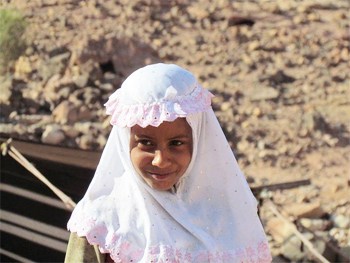
Meals are served in a covered shelter and there is running water so you’ll find it to be a pretty “civilized” experience. That’s good because it means you don’t have to come equipped with all your camping gear – no need for sleeping bags, cook stoves, fuel, food, etc. It’s all here. Even showers!
Stunning Beauty
But, that doesn’t mean you can’t have an outdoor experience. The surrounding area is stunning in its beauty and there are trails surrounding the area that could provide hiking for days – or weeks. I got out for an early morning hike and discovered a beautiful small arch and some fascinating rock formations within a very short distance from the campsite.
The plan for the day was a 15-kilometer hike from the nearby Dana Village to the Feynan Eco Lodge. Plan on 4 or 5 hours to allow time for enjoying the view, stopping for snacks and taking lots of photos. It’s mostly downhill and it’s a pretty easy hike – it just might be a little long if you’re not in good condition.
When you arrive at Feynan you’ll discover that there are only candles for light and the desert quiet engages your senses to listen for the birds and creatures of the night. You’ll also find that you can leave your comfortable room and sleep on a mat on the roof if you like. But, you don’t have to stay there all night, maybe just long enough to view the Milky Way and catch a few shooting stars before returning to your candle-lit haven.
Considerably more difficult than the 15k hike was my trek from Petra to visit Aaron’s Tomb atop Mount Hor, the highest peak in Petra. I began this hike at the entrance to the Rose Red City so I was able to refresh my memory of this wondrous place.
After meeting my young Bedouin guide, we walked the Siq, passed the Treasury and the other wonderful antiquities of Petra and followed a trail for a couple of hours to the base of Mount Hor.
Catch a Ride on a Jeep
I later learned that I could have caught a ride on a jeep or pickup to the foot of the mountain, but I really think the walk was a better choice. Along the way we stopped and talked with friends and family members of my guide.
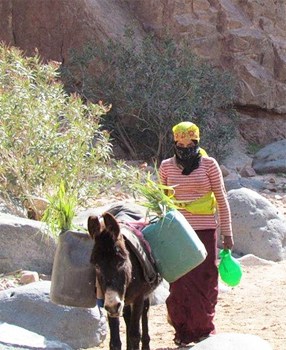
The two-hour hike through soft, pink desert sand was a bit tiring, but the sighting of the tiny monument at the top of the mountain was revitalizing.
It was not really such a tiny monument, the distance to the top of Mount Hor was a bit deceptive and after another hour and a half we reached a Bedouin encampment where the resident held a key to a gate that had to be passed in order to continue to the top of the mountain and Aaron’s Tomb. Weary from the hike to and up the mountain I took the key and proceeded alone to the tomb. The last thing I wanted to face at the end of a very long hike was a series of steps.
I didn’t count them but can attest that there were too many. Maybe I should have caught a ride in a jeep. Nevertheless, the final ascent of those terrible stairs was rewarded with a fantastic 360-degree view.
I don’t have room here to describe the religious significance of Aaron’s Tomb, Petra or the many religious sites throughout Jordan, but I can tell you that a tour of Biblical Jordan could keep you traveling for weeks.
Meeting Bedouin shepherds along the way, stopping and sharing tea with a local family, viewing some structures as fabulous as the “main street” of Petra, and having the opportunity to pass

closely by families still living in caves coupled with the spectacular beauty of the area made the long walk to Aaron’s Tomb one of the highlights of my most recent visit to Jordan.
But, for me at least, the best was yet to come. The one thing that I wanted to do more than anything else on this trip was to hike in the Wadi Mujib. I had some expectations about this hike, but nothing I had read about it quite prepared me for what was to come.
The evening before this final adventure of the trip
our small party arrived at the Mujib Chalets, a cluster of cute little one-room structures each facing the Dead Sea only a few meters away.
Salty Rocks
No running water, but washrooms and hot showers nearby. When I walked down to the water’s edge I found large rocks completely covered in salt. At about 400 meters below sea level, this was to be the starting point for our Wadi Mujib experience the following day.
The next morning we crossed the road and found the entrance to the Wadi Mujib, the lowest nature reserve on earth, where we met our guide for the day, a congenial, knowledgeable and extremely competent outdoorsman. After introductions and a few words of caution for the day ahead, we began our hike up a couple of very long, arduous hills. Why are we walking so far uphill to get to a point at the bottom of a canyon? It turns out that to make a circuitous hike that gets us back to the starting point we have to hike inland for an hour or so.
The path through the Wadi Mujib is the Mujib River, one of the last wild rivers in the Kingdom. The canyon walls are as high as 50 meters in some places. There is more than one hike available in the Mujib Nature Reserve and we do a little exploring. Our first direction leads up through a wider, more open stretch that finds us scrambling over large boulders, walking along a few ledges and starting to get our feet wet. Soon we’re completely soaked, occasionally underwater but always having a great time.
The water is comfortable – we learn that it begins as a warm spring and is cooled as it moves downstream toward the Dead Sea.
The canyon walls look as if they could have been painted. The colors are beautiful with bright accents along the way created by the various minerals in the rock. After we come to what is for us a dead end we turn around and go back to a place where we have left our backpacks and climb atop a giant boulder to sit in the sun, enjoy our lunch and empty the small pebbles from our water shoes.
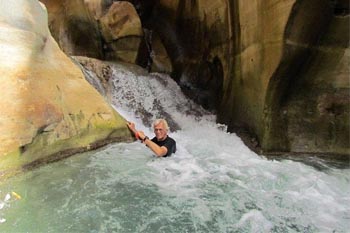
My Merrell water sandals have accumulated a few pebbles, but have functioned well. It might have been possible to proceed farther, but I think some more technical gear might have been required. Besides, we still have a few hours to hike along another canyon with some special surprises along the way.
So far, the most difficult part of the hike has been doing it with only one hand. Although I had a small waterproof camera along, I wanted my larger one to capture some of the events still ahead.
But, it was difficult to maneuver on and around the boulders with rushing water while trying to hold the camera out of harm’s way.
Rushing River
After lunch, it is just a short hike back to where the second canyon splits off and we quickly see the beauty and enormity of this canyon. This is where we find the narrow slot and high walls so reminiscent of many slot canyons in Utah and the Southwestern United States. But, the colors here are different and the canyon has a magic all its own. The force of the water is often very strong and we occasionally find that a helping hand is needed to get across and over some of the boulders that serve as funnels for the rushing river.
There are places where I find myself chest deep and we have one of our group who is just about that tall. But, she is an excellent hiker and in great condition. I learned earlier that she is a dancer and maintains a daily routine that pays off well on this hike.
We encounter one challenge after another. There are now frequent “slides” where we just have to sit down and slide over and off the boulders into the water beyond. Every step forward is more interesting, exciting and challenging than the last – this is the hike I was searching for!
Rappelling down Waterfalls
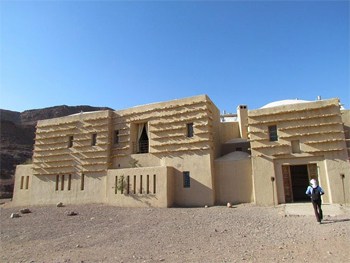
And close to the end comes a surprise for some who have never had the experience before – to get to the finish we have to rappel down a couple of waterfalls. They’re not terribly high – about 20 meters, but toward the bottom, we’re in the full force of the falls and the water is flowing rapidly. Happily, everyone succeeds and the first-timers have a new experience under their belts.
Following the falls, we have a couple more difficult boulders to cross, but they have ropes attached so it helps us get down. Trying to do it with one hand and my camera held high over my head, I get swept to one side into a hole that is over my head. I guess all the others can see is one hand with a camera in it.
It takes me a minute to get my footing to get out of the hole and all is well. It’s just a short walk through shallow water to the end of the trail and the Dead Sea. One more night, spent at the Dead Sea Moevenpick as a reward for all the strenuous activity, and it’s time to say goodbye to newfound friends and the delights of one of my favorite adventure destinations – the Hashemite Kingdom of Jordan.
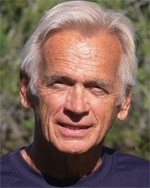
Robert Painter travels the globe seeking interesting destinations and stories for his readers.
- These 9 U.S. National Parks Require Reservations in 2024 - April 17, 2024
- Take a Hike in Olympic National Park - April 17, 2024
- The Wild Mississippi: 2340 Miles Across Ten States - April 8, 2024


